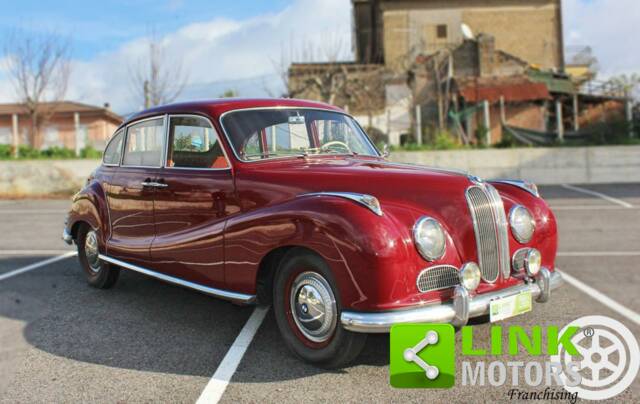BMW 501 classic cars for sale
The BMW 501 stands as BMW’s postwar return to luxury motoring, renowned for its distinctive curves, advanced safety features and meticulously crafted interiors. This model attracts connoisseurs searching for a rare classic with genuine period character and uncompromising build quality.
Search results

1954 | BMW 501 A
BMW 501 A ASI
History of the BMW 501
Launched in 1952 and first revealed at the 1951 Frankfurt Motor Show, the BMW 501 was the brand’s first in-house car after WWII and marked a major milestone for BMW, now producing in Munich. It was quickly given the nickname 'Baroque Angel' because of its elaborate bodyshell. Initially powered by an updated six-cylinder from the prewar 326 and later joined by V8 options, the 501 combined innovation with tradition. Multiple engineers contributed to its creation, with Peter Schimanowski shaping its unmistakable exterior and Alfred Böning responsible for mechanicals. Its luxurious focus reflected BMW’s ambition to reclaim a premium reputation in postwar Germany despite a challenging market and high price point.
Model history
The BMW 501 had no immediate in-house predecessor as the Eisenach-built prewar 326 and 340 series were no longer in BMW’s West German hands. The 501 would serve as the foundation for BMW's upper-class saloon lineup. The range evolved through the 501A/501B revisions with improved engines and price adjustments before culminating in the introduction of the 501/3 and limited 501 V8—the latter overlapping with the debut of the 502 series. Official output ended in 1958, paving the way for later models like the BMW 2500 and 2800 of the E3 series.
Highlights and Features
Noteworthy for its robust construction and ample use of quality materials, the 501 was a showcase of craftsmanship: elaborate upholstery, curved glass, a detailed dashboard, and numerous chrome fittings. The frame included advanced safety ideas, such as integrated side-impact protection and an atypically-placed fuel tank for crash safety. Interior distinctions included a steering-column gear change, generous front footwell space, fold-back rear windows, and options for original fabric or leather seating. Its pronounced curved fenders and compact rear window are distinguishing exterior features. The car’s exclusivity is underlined by the small production run of just about 9,000 units, with even rarer Cabriolet and Coupé variants produced chiefly on bespoke order through companies like Baur and Autenrieth.
Technical data
Special editions and rare models
Of the limited 501 production, fewer than 300 Cabriolets and Coupés—mainly executed by coachbuilders Baur and Autenrieth in 1954/55—stand out as extremely rare, bespoke collector’s pieces. A handful of 501s were also delivered with the V8 engine beyond the more commonly badged 502, making these hybrids highly sought after. Luxury equipment variants included optional fabric or leather seats, electric radios, original whitewall tires and sliding roofs.
Weak spots and common issues
The BMW 501’s solid design and thorough restoration standards mean rust is less common than in many classics, but sourcing original spare parts—such as the engine compartment toolset—can be difficult. Mechanical maintenance can be challenging due to the uncommon engine/transmission layout and specific restoration requirements. Documentation, including period handbooks and parts books, is invaluable for ownership, but restoring interior details and rare accessories can demand expert support.
Engine, transmission and driving characteristics
The initial 2.0-litre inline six was considered modest for the heavy construction, resulting in relatively subdued acceleration (0–100 km/h in around 27 seconds and a top speed near 135 km/h). The car’s ride comfort, thanks to its sophisticated suspension and weight, earned praise, but the steering-column shifter, though freeing up legroom, could feel vague. The six-cylinder’s later upgrade to a 2.1-litre and the introduction of the V8 transformed the car’s character, making the later versions markedly more engaging. Braking relied on drums, which can fade under stress but suit leisurely driving. Most 501s were sedans, but convertible and coupé versions, often hand-built, combined a unique driving flair with unparalleled rarity. - 501/3: Features the largest six-cylinder engine, improved performance.
- 501 V8: Limited examples with aluminium V8, crossover with early 502.
- Cabriolet/Coupé: Extraordinarily rare, coachbuilt luxury.
Interior, comfort and design
Peter Schimanowski sculpted the 501’s curved, layered body with a pronounced waistline and 'Baroque' arches. The front features the signature double-kidney grille flanked by large sets of lamps ('Langblinker' in later cars) and distinctive bumpers. Early models had small rear windows and restrained chrome, while later restyles added visual accents. Luxurious interiors combined stout wood trim with marbled dashboard switches and soft fabric or leather upholstery, and features like an overhead clock, two-stage heating, sunroof, and armrest. Numerous details—foldable rear side windows, period radios with mini-jack, and accessory toolkits—add to its period appeal. Original Michelin whitewall tyres and bespoke details such as marble-finish dashboard knobs further set it apart.
Further points of interest
Many BMW 501s were commissioned for use by the police and fire services, a testament to the car’s sturdy design and reliable mechanicals. Well-maintained examples often carry historic number plates and are prized for their authentic documentation and certified appraisals ('Wertgutachten'). Restoration excellence ('frame-off') and the ability to retrofit period enhancements (electronic ignition, electric fuel pumps, auxiliary fans) add practicality to historic charm. The car’s place in the German motoring comeback story after WWII adds cultural resonance for collectors.
Summary
The BMW 501 set the pattern for postwar German luxury saloons, blending advanced engineering with high craftsmanship and a distinctive presence. Its scarcity, history, and meticulously detailed construction make it a uniquely desirable classic for enthusiasts seeking a machine that stands out as much in technical intrigue as it does in visual drama—particularly in rarer Coupé or Cabriolet forms.
